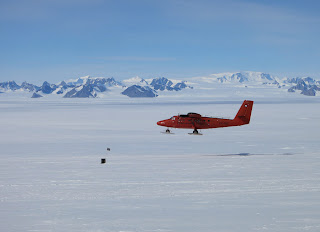 |
| Fast ice, southern Marguerite Bay |
 |
| The controls and dials from co-pilot seat |
 |
| Alexander Island |
 |
| Cargo for the fuel depot (up to weight limit for the plane) |
 |
| The cottage |
 |
| George VI Sound and Alexander Island |
 |
| Glacier flowing into the ice sheet |
 |
| Glacier going one way meets ice sheet going another |
 |
| Chris co-piloting on the way north |
 |
| Empty oil drums and a P-Bag (sleeping bag, mats, thermorests and sheepskins) |
 |
| Jenny Island, as we approached Rothera |
I finally got to fly off station, for a six day stay at Fossil Bluff mid season. The Twin Otters are fantastic pieces of kit, flying out from base to either manned fuel depots (Fossil Bluff and Sky Blu) or to unknown areas of snow where the pilots fly low to check out the area for crevasses and strasugi and, if happy, land.
On the way south I was co-pilot so flew the plane most of the way (except take-off, landing and a break for photos) while the pilot did the paperwork. The cargo was five oil drums, to maintain the depot for planes going further afield. On the way back I was a passenger, so more chance for photos. It also allowed me to check the ice conditions for my ocean glider (basically a remote controlled submarine) so I could send it further afield.





















































